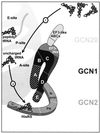Gcn4p, a master regulator of gene expression, is controlled at multiple levels by diverse signals of starvation and stress
- PMID: 12455968
- PMCID: PMC118051
- DOI: 10.1128/EC.01.1.22-32.2002
Gcn4p, a master regulator of gene expression, is controlled at multiple levels by diverse signals of starvation and stress
Figures



Similar articles
-
Transcriptional profiling shows that Gcn4p is a master regulator of gene expression during amino acid starvation in yeast.Mol Cell Biol. 2001 Jul;21(13):4347-68. doi: 10.1128/MCB.21.13.4347-4368.2001. Mol Cell Biol. 2001. PMID: 11390663 Free PMC article.
-
Amino acid starvation and Gcn4p regulate adhesive growth and FLO11 gene expression in Saccharomyces cerevisiae.Mol Biol Cell. 2003 Oct;14(10):4272-84. doi: 10.1091/mbc.e03-01-0042. Epub 2003 Jun 27. Mol Biol Cell. 2003. PMID: 14517335 Free PMC article.
-
Amino acid-dependent Gcn4p stability regulation occurs exclusively in the yeast nucleus.Eukaryot Cell. 2002 Oct;1(5):663-72. doi: 10.1128/EC.1.5.663-672.2002. Eukaryot Cell. 2002. PMID: 12455686 Free PMC article.
-
Controlling transcription by destruction: the regulation of yeast Gcn4p stability.Curr Genet. 2003 Oct;44(1):8-18. doi: 10.1007/s00294-003-0422-3. Epub 2003 Jul 9. Curr Genet. 2003. PMID: 14508604 Review.
-
Regulation of translation in eukaryotic systems.Annu Rev Cell Biol. 1992;8:197-225. doi: 10.1146/annurev.cb.08.110192.001213. Annu Rev Cell Biol. 1992. PMID: 1335743 Review. No abstract available.
Cited by
-
Discovering RNA-protein interactome by using chemical context profiling of the RNA-protein interface.Cell Rep. 2013 May 30;3(5):1703-13. doi: 10.1016/j.celrep.2013.04.010. Epub 2013 May 9. Cell Rep. 2013. PMID: 23665222 Free PMC article.
-
Multiprotein-bridging factor 1 regulates vegetative growth, osmotic stress, and virulence in Magnaporthe oryzae.Curr Genet. 2017 May;63(2):293-309. doi: 10.1007/s00294-016-0636-9. Epub 2016 Aug 2. Curr Genet. 2017. PMID: 27485943
-
Regulation of amino acid, nucleotide, and phosphate metabolism in Saccharomyces cerevisiae.Genetics. 2012 Mar;190(3):885-929. doi: 10.1534/genetics.111.133306. Genetics. 2012. PMID: 22419079 Free PMC article.
-
Stress-activated protein kinase pathway functions to support protein synthesis and translational adaptation in response to environmental stress in fission yeast.Eukaryot Cell. 2005 Nov;4(11):1785-93. doi: 10.1128/EC.4.11.1785-1793.2005. Eukaryot Cell. 2005. PMID: 16278445 Free PMC article.
-
Accessibility of promoter DNA is not the primary determinant of chromatin-mediated gene regulation.Genome Res. 2019 Dec;29(12):1985-1995. doi: 10.1101/gr.249326.119. Epub 2019 Sep 11. Genome Res. 2019. PMID: 31511305 Free PMC article.
References
-
- Albrecht, G., H. U. Mosch, B. Hoffmann, U. Reusser, and G. H. Braus. 1998. Monitoring the Gcn4 protein-mediated response in the yeast Saccharomyces cerevisiae. J. Biol. Chem. 273:12696-12702. - PubMed
-
- Arndt, K. T., C. Styles, and G. R. Fink. 1987. Multiple global regulators control HIS4 transcription in yeast. Science 237:874-880. - PubMed
-
- Beck, T., and M. N. Hall. 1999. The TOR signalling pathway controls nuclear localization of nutrient-regulated transcription factors. Nature 402:689-692. - PubMed
-
- Berlanga, J. J., J. Santoyo, and C. De Haro. 1999. Characterization of a mammalian homolog of the GCN2 eukaryotic initiation factor 2alpha kinase. Eur. J. Biochem. 265:754-762. - PubMed
Publication types
MeSH terms
Substances
LinkOut - more resources
Full Text Sources
Molecular Biology Databases

